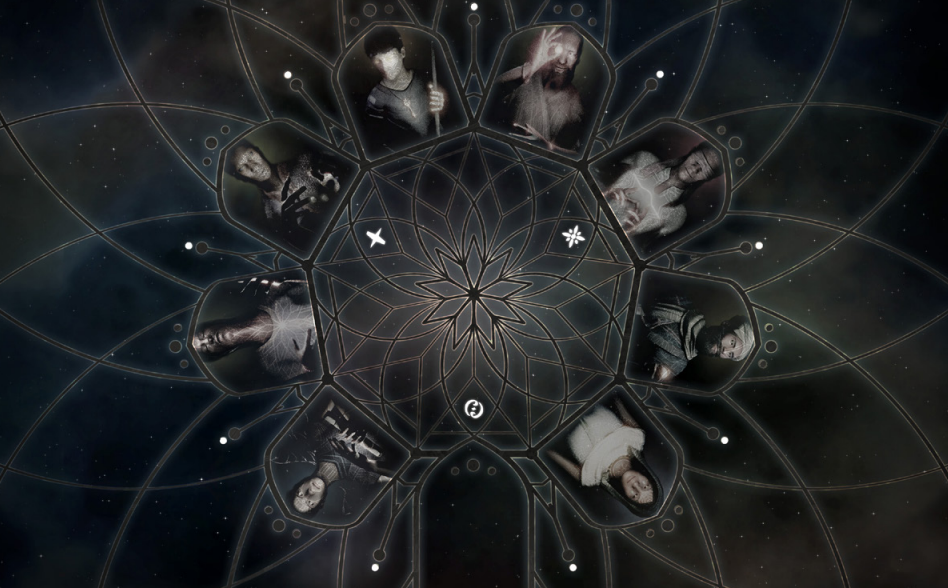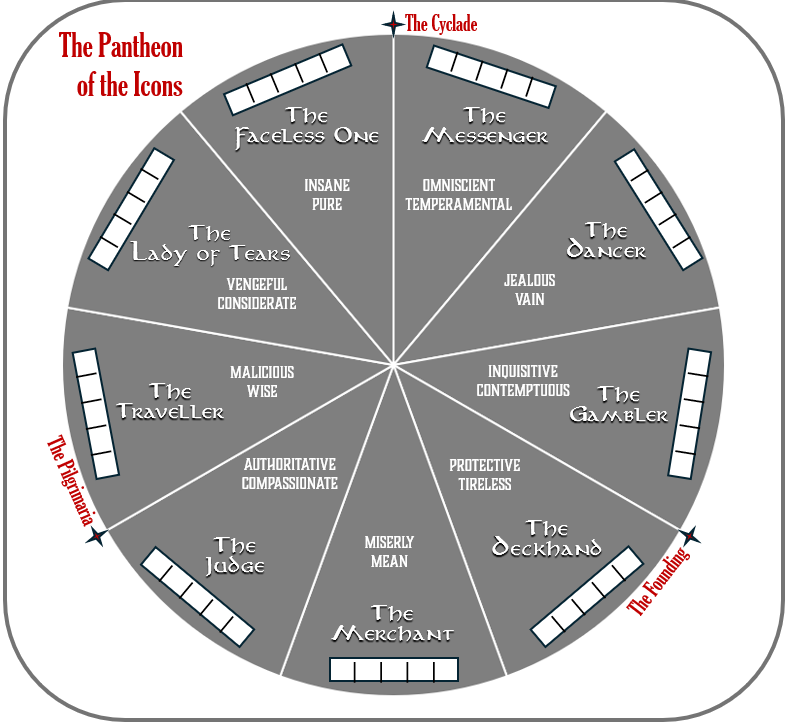
Bringing the Icons into your game
The Icons of the Third Horizon are akin to the pantheon of the Greek Gods – supernatural entities but with the desires, whims and motivations of normal people. They can be pleased, appeased, displeased or angered by the worship and prayers of mortals. They can be petty, vindictive and vengeful, or in the right mood, generous, compassionate and loving. They also compete with one another, a constant politicking in the heaven-like dark between the stars, taking out their frustrations on the mortals who dare to call for their aid in a moment of crisis.
These rules bring the Icons to your players, building a personal relationship with distant deities who sometimes listen, sometimes don’t. Each Icon has two aspects that drive their behaviour:
THE MESSENGER: The whisperer, the knower of secrets, nothing is kept from the Messenger. But they are unpredicatable. Their aspects are OMNISCIENT and TEMPERAMENTAL.
THE DANCER: The Dancer is the bond between lovers, or in another guise the personification of lust. Her dark side is the Beast, perhaps formed by a jilted lover. The Dancer is a jealous Icon, vindictive if not treated well. Her aspects are be JEALOUS and VAIN.
THE GAMBLER: Adventurous, curious, a trickster, who hates cowards and those who take no risks. He is INQUISITIVE and CONTEMPTUOUS.
THE JUDGE: The Judge presides over the afterlife, and as such should be the Princeps—first citizen—of the Icons. But he is not, and the Messenger rules over him. The Judge is still senior and carries much clout in the pantheon. The Judge’s alternate side, the Martyr, willingly takes trouble for the other Icons, accepts unjust punishments for the greater good. As such, the Judge is AUTHORITATIVE and COMPASSIONATE.
THE TRAVELLER: The Star Singer, the one who spreads wisdom. But the Traveller is also depicted as Demiurge, the evil cosmic spider who controls the web of travel and transport, and perhaps was the original portal creator. His aspects are WISE and MALICIOUS.
THE FACELESS ONE: The closest Icon to the dark between the stars, known as the Shadow That Brings Madness. As such, many see this Icon as the purest of them all. The Faceless One is PURE but INSANE.
THE LADY OF TEARS: The Lady of Tears is the escort of the dead, guiding those once-mortal souls to the afterlife. As such, and as the Judge presides over the afterlife, she is subservient to that Icon. But she has an angry side, shown in her power over the element of fire. She is CONSIDERATE, but VINDICTIVE.
THE MERCHANT: The Merchant is depicted as either a fat, jolly man, or a kindly elderly woman, but is neither jolly nor kindly. The Merchant expects—nay demands!—tribute, and cares nothing for the mortals who must provide it. That makes them MISERLY and MEAN.
THE DECKHAND: The Deckhand is depicted as a tired boy with broom in hand, who blesses the home and hearth, ships and cargo. He protects the oppressed and down-trodden, and I think that’s because he is put-upon and down-trodden in the Icon pantheon. His aspects are PROTECTIVE and TIRELESS.

The Icons in Play
When invoking the Icons, by pushing a roll or worshipping in a chapel, the players must always nominate the specific Icon they are calling out to. If they are pushing a roll having had the good sense to complete preparatory prayer for the divine push bonus, they must call upon the Icon that blessed them to get the bonus. Each time they call for an Icon’s help and push their roll the player records the fact they have pushed (marks off one of the five boxes next to the Icon on the Pantheon sheet – see below). This records how much the player character is calling upon – aka bothering – that Icon. Mark the box with a tick if the outcome of the pushed roll was successful, or with a cross if the outcome was mediocre, poor or an outright failure.
Once the PC has called upon the same Icon three times (i.e., when they have pushed three times, and three tick boxes are checked) something happens:
- If the pushed rolls have generally been successful (i.e., there are more ticks than crosses) the Icon who has been called upon for help is happy. However, one of the other eight Icons is jealous at the attention the player character is giving that other Icon. The GM immediately gains an extra Darkness Point due to that divine outrage, and must spend it as soon as possible against the player character in question. This represents the other Icon’s jealous anger, and the action resulting from that DP should relate to one of that Icon’s two aspects in some way.
- If the pushed rolls have generally been unsuccessful (more crosses than ticks) then the Icon who has been called upon is not enjoying the constant demands on their attention, and gets angry. The GM gets a Darkness Point to spend on the PC in question, but this time the outcome depends on the specific Icon’s aspects.
- At this point, if the Icon is unhappy, the check boxes are all wiped clean, and the PC starts again with no boxes ticked or crossed.
- If the Icon is happy the boxes remain checked. Future pushes fill out the fourth and fifth boxes, again with a tick for success or cross for failure. If, after all five boxes are checked, at least four of them have ticks, the Icon is delighted with that character and they become Honoured of that Icon – being Honoured brings them a +1 bonus to every die roll from now on. That is, until they fail a pushed test, and the Icon gets bored with them. Then the track is reset to the beginning.
If, at any time, a player character is soooo devout they become Honoured with two Icons simultaneously, they must choose between them. They gain the Honoured bonus from the Icon they choose, but the rejected Icon is incandescent with rage. Any attempt to pray to that Icon, at a chapel, during a push, or elsewhere, is an automatic fail, including a pushed roll that had successes before the roll was pushed. This lasts until the blessing of the other Icon expires, and all the Icons are back to being equal in the eyes of the righteous.
An Example:
The Faceless One has been called upon three times, and the rolls have gone well. The other Icons are envious that the mortals have not called upon them instead. The GM decides the Gambler – with his aspects of INQUISITIVE and CONTEMPTUOUS – has been angered, and gets a Darkness Point to spend against the PC immediately. This allows the GM to change the narrative in a fun way, based on the aspects of the angry Icon. Perhaps a nearby guard, journalist, Inquisitor or neighbourhood watch warden becomes suddenly inquisitive into what’s been going on, and gets involved, or maybe a friend or important NPC, perhaps involved in a tense scene or negotiation, suddenly takes offence for no obvious reason, and becomes contemptuous of the player characters.
However, if the rolls had gone badly, the Faceless One would be angry at the mortal’s imposition. Their aspects, of PURE and INSANE, come into play as the Faceless One exacts retribution. Perhaps the PC goes temporarily mad or out of their mind, or a nearby ally or enemy goes bonkers. Alternatively, maybe a bystander sees the Icon’s purity shining through the player character, and they gain an unwelcome NPC hanger-on or groupie at a time when they could really do without.
Below is a link for the Pantheon sheet, should you wish to bring these ideas to your table:
